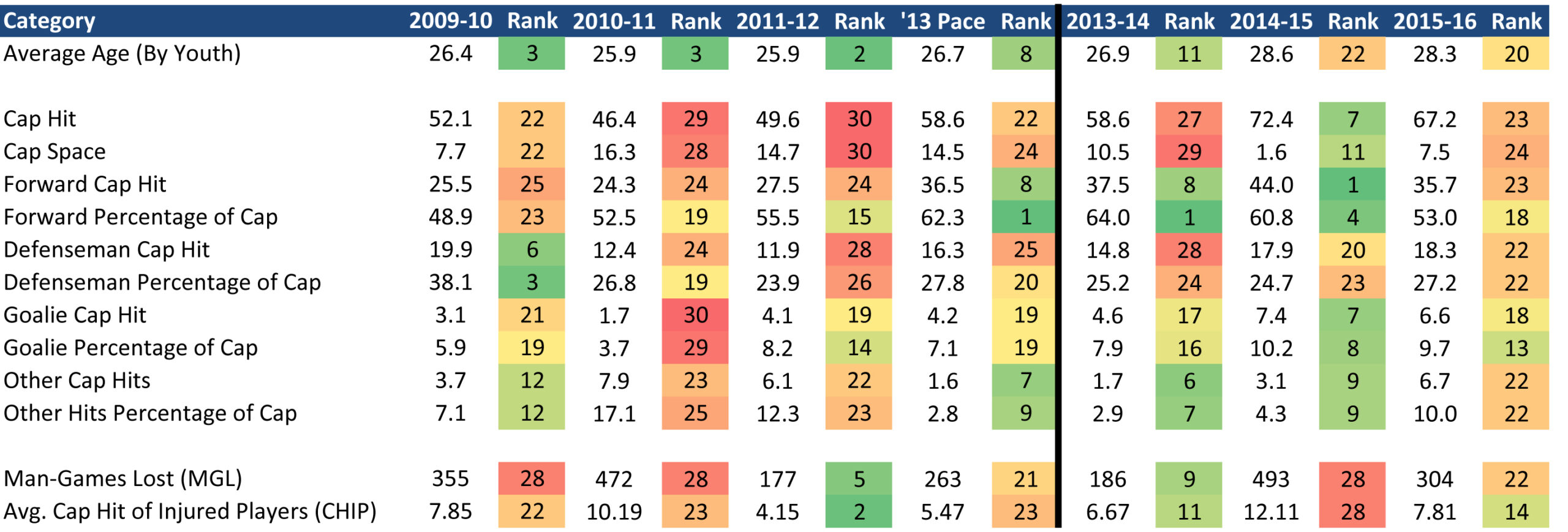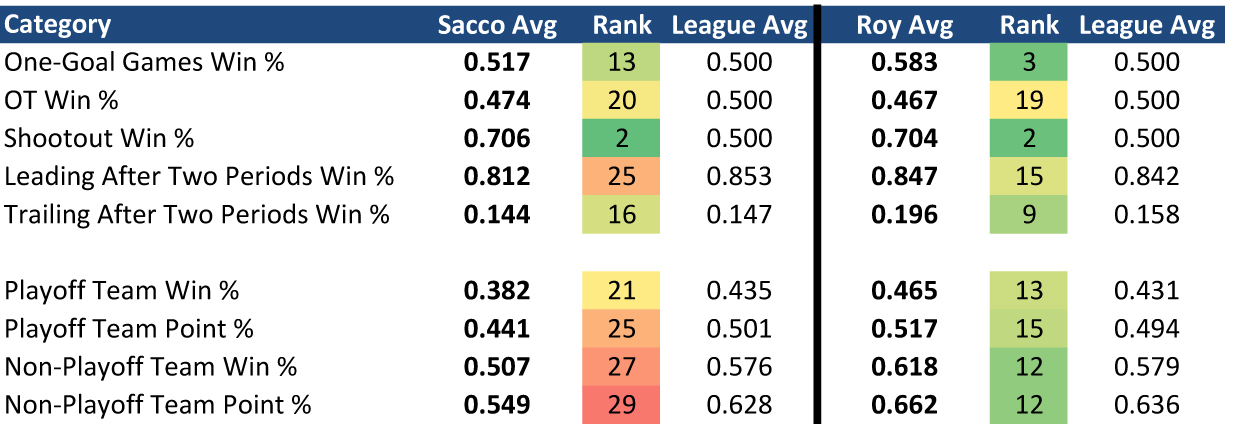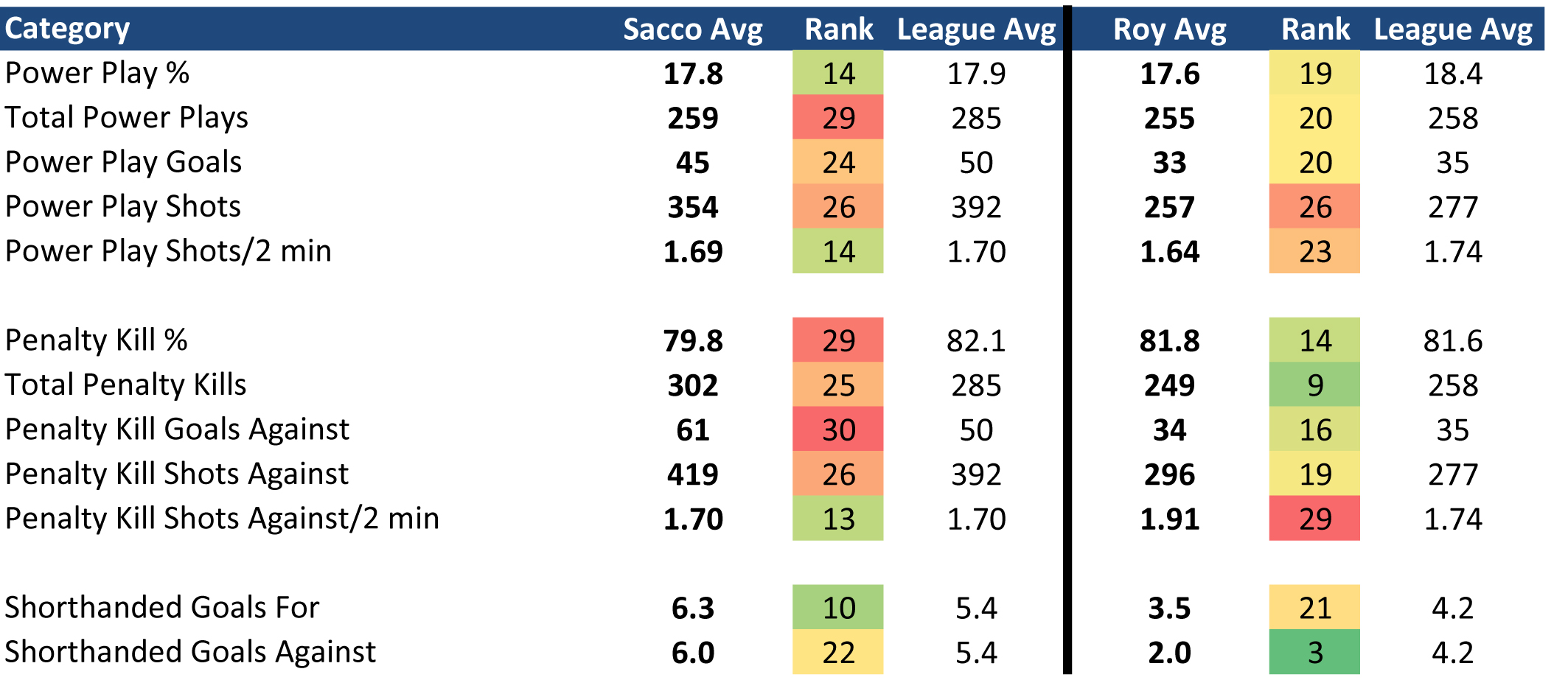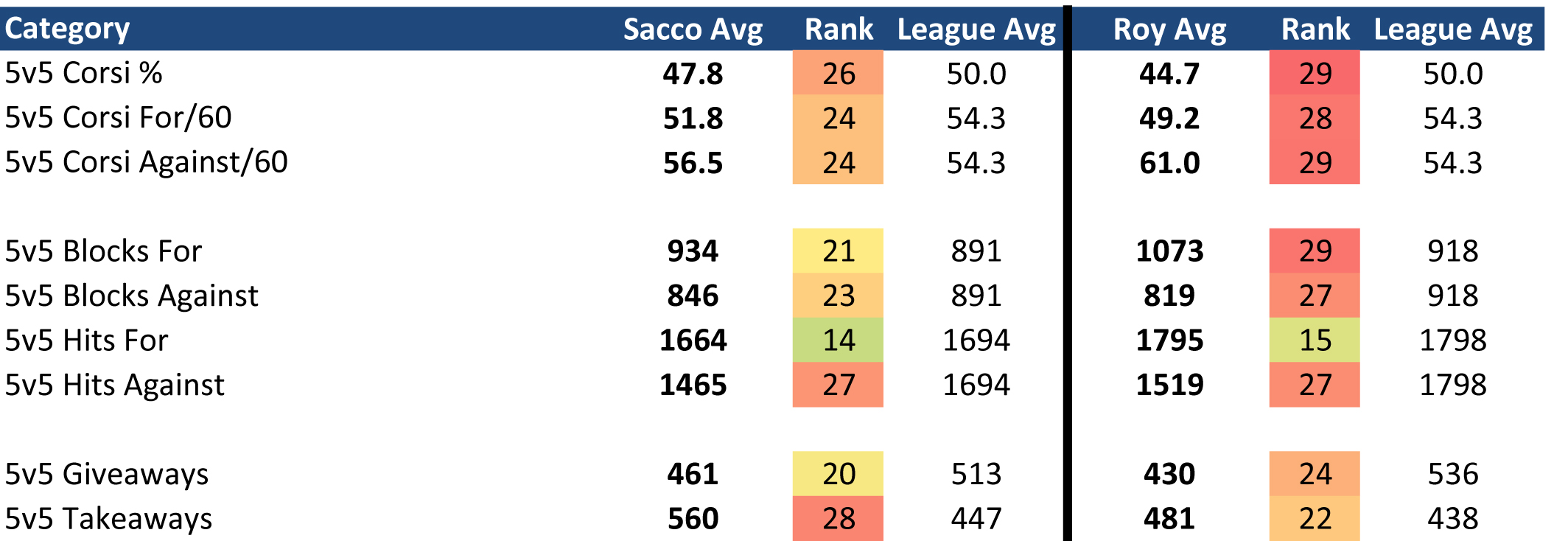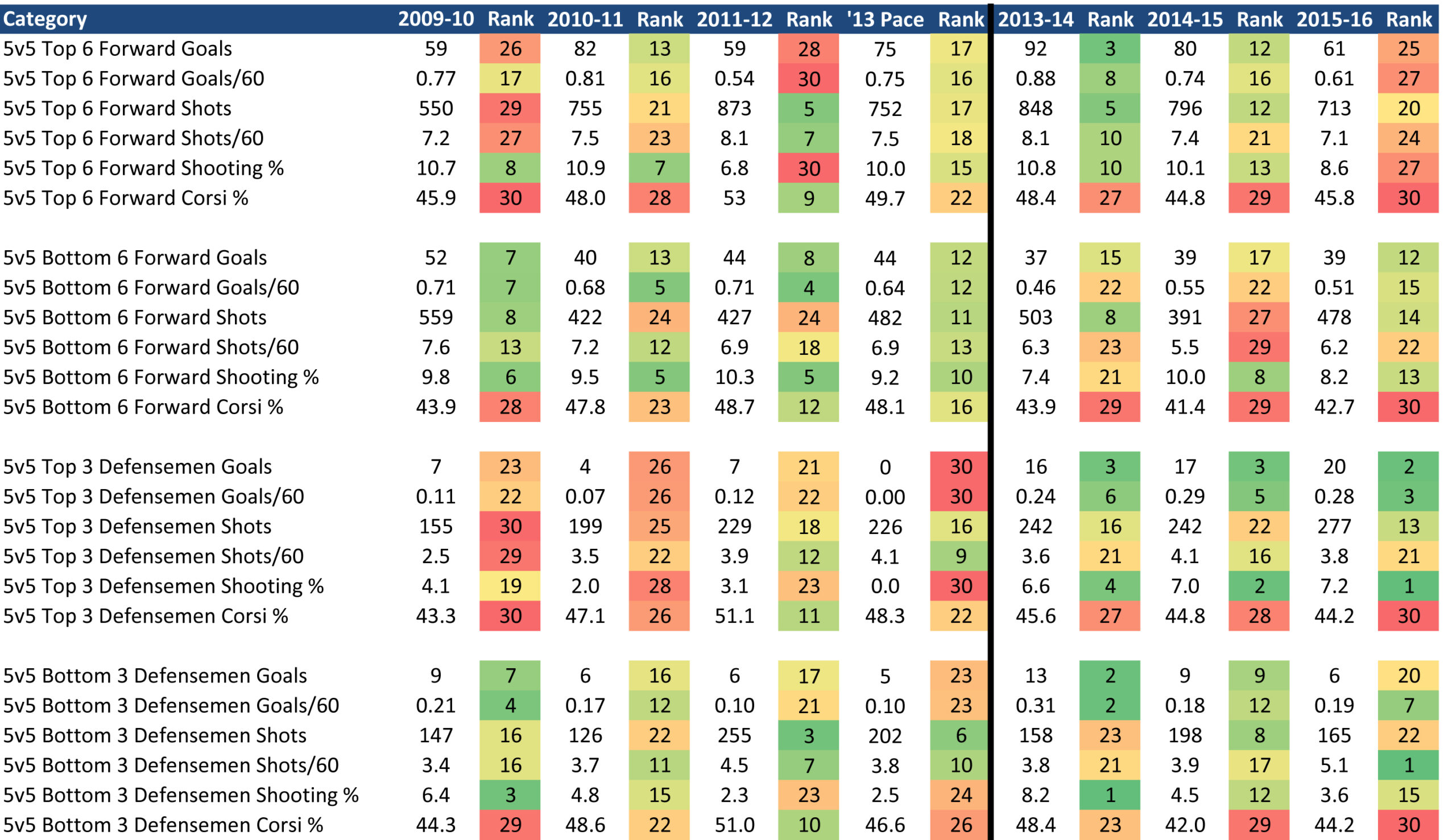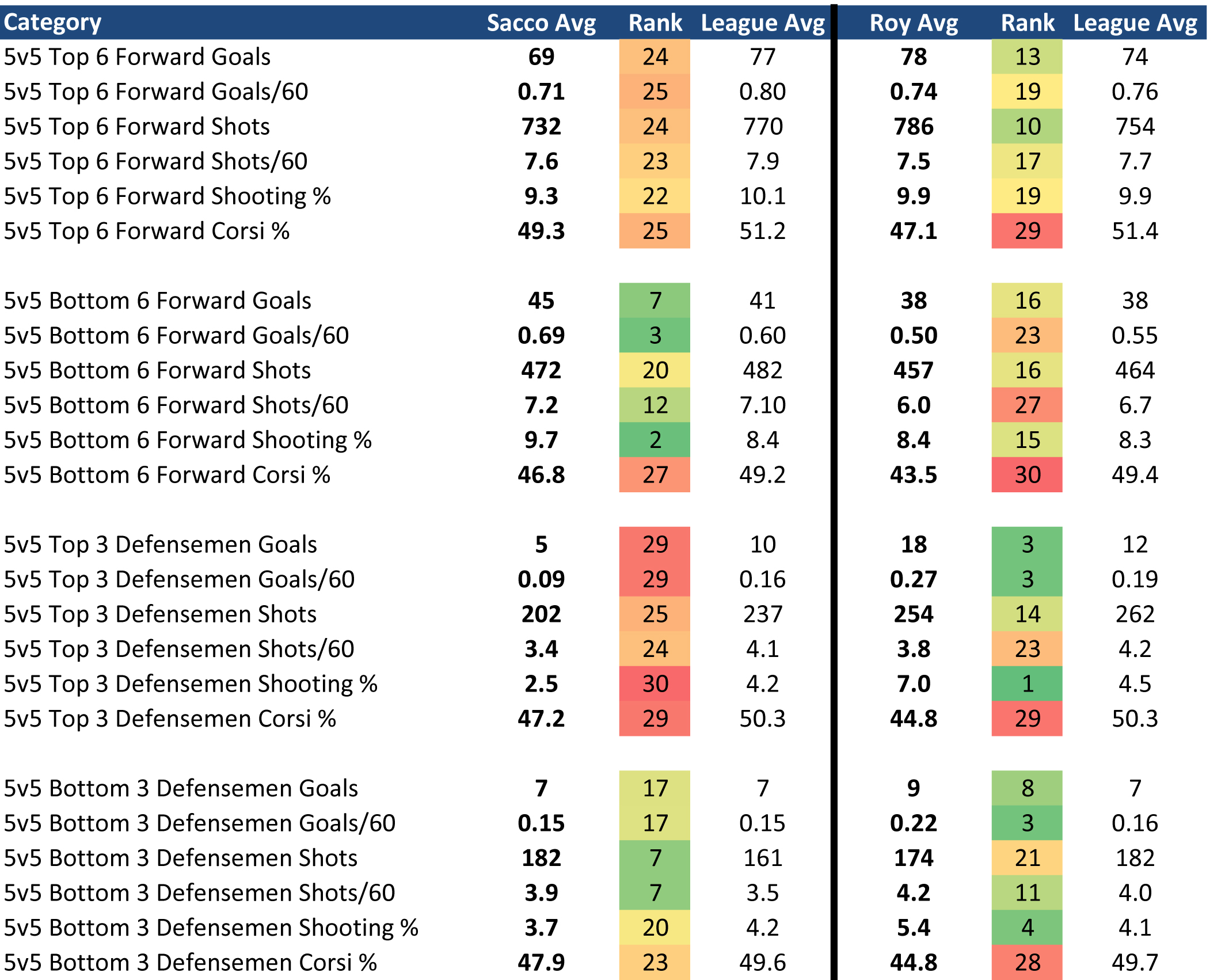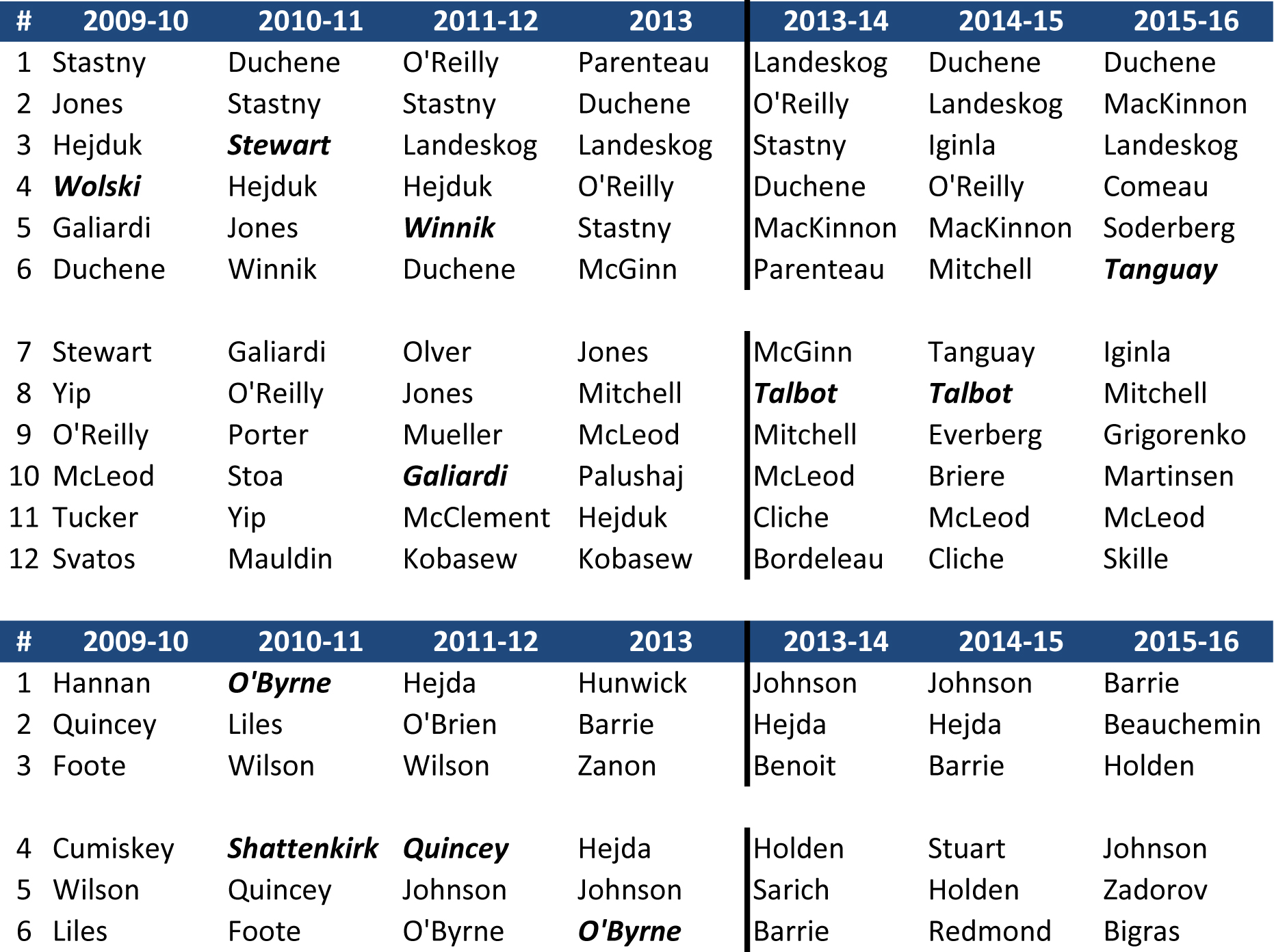© 2025 ALLCITY Network Inc.
All rights reserved.

This week marks a fresh start, a new beginning, and a next era for the Colorado Avalanche under the leadership of their recently hired head coach, Jared Bednar. After the unexpected departure of Patrick Roy this summer, the team had very little choice but to head in a different direction, which, given their recent lackluster finishes, may have been the best situation for everyone involved.
Even so, sorting out just what kind of team Bednar is inheriting isn’t an easy task. Roy was never shy about enacting unusual systems that broke both the traditional and analytical norms. Some ideas worked; many others didn’t. Unfortunately, sorting out just how much of an impact he had on the roster and what is left now that he’s gone is an extremely murky area.
While one could use other teams in the league to somewhat judge this impact, that sort of broad thinking – while helpful – ignores any idiosyncrasies that might exist specifically on the Avs roster. So, in the end, perhaps the best proxy available to analyze this team without the Roy Effect is to look at the seasons before he arrived.
What has changed since Joe Sacco, what hasn’t, and what does this mean for Bednar moving forward?
In order to untangle this riddle, stats were pulled and analyzed data from War on Ice, Corsica, Hockey Reference, Hockey Analysis, General Fanager, NHL Numbers, and NHL.com. Thomas Crawshaw of NHL Injury Viz also graciously provided the notoriously difficult to track down man-game lost statistics.
In the end, 88 statistics across eight broad areas will hopefully provide enough context to objectively judge the state of the team. The Avs league-wide rankings are also included in color to illustrate how their strengths and weaknesses have shifted across the seven-year span. There’s a lot to unpack, so only a few key factors will be touched on beneath each of the charts.
In the end, some answers – and opportunities – should emerge.
Average Age, Salaries, & Injuries
Before digging in too deeply to the on-ice stats, it’s worth taking a look at their off-ice data. Many of these aspects are out of Bednar’s control, but they’ll certainly have an effect on his roster.
Mix of Veterans and Younger Players
Significant Change from Sacco to Roy: Yes. The team went from one of the youngest in the league to slightly above the average in a very short period of time.
Analysis: It’s probably not a coincidence that the jump in age came directly after a very inexperienced Avs team found themselves in the postseason. The 2013-14 roster shared only 412 playoff games shared between them, and only two players who suited up – Max Talbot and Cory Sarich – had seen the playoffs more than twice.
Given the club’s subsequent disappointing showing, Sakic spent that summer restructuring the roster to add more veterans. While some of those moves were less than successful, they, combined with an emphasis on drafting and development, created a current roster with many different age groups represented.
What this Means for Bednar: The expected addition of Mikko Rantanen and increased roles for young players like Nikita Zadorov and Mikhail Grigorenko should bring down the average age from last season, but the veterans like Jarome Iginla and Francois Beauchemin are still around to help mentor and keep everything in perspective. The “core” players have also matured since that rollercoaster ’13-14 postseason and are now in the prime of their careers.
How Bednar uses those age groups is obviously much more important than simply having them, but there aren’t any glaring needs when it comes to youth or experience anymore.
Spending
Significant Change from Sacco to Roy: Yes and No. Overall, no, the Avs have maintained below-average spending throughout the tenure of both coaches. However, they were top ten in spending during 2014-15 after their playoff appearance, and are expected to be in that range for this year as well.
Analysis: Icing a competitive team takes money, and by-and-large, that has not happened in Colorado under Sacco or Roy. For six of the past seven seasons, this club has not been given a fair chance to finish high in the standings, so their overall lack of doing so is at least partially at the feet of their ownership.
However, the team was in a rebuild for most of that time. In the cap era, star players can only reliably be acquired from the very top of the draft, but in order to get them, teams have to fail and fail hard. The Avs decided against bringing in pricey, in-their-prime veterans and instead prioritized minutes for the young and cheap “players of the future”. They then filled out the rest of the roster with mediocre players who came cheaply and wouldn’t hurt the draft position.
In the end, ownership got exactly what they paid for – bad hockey and three top three picks.
In the years since the Avs have shown a willingness to spend on at least their forwards. Except for the Brad Stuart buyout, they don’t have any notable dead weight on the books, nor do they have any crippling overpayments running deep into the future. They’ve been slightly above average at dedicating their cap space to only the active roster, and they have all of the core locked up on reasonable contracts for at least three more years.
What this Means for Bednar: Moving forward, signs point to an ownership willing to spend and a roster that should justify the commitment. Their recent lack of doing so doesn’t exactly inspire confidence, but the Avs have historically spent more time near the top of the salary list than near the bottom.
As they come out of their prolonged rebuild, when the ownership decides to spend to contend, the front office won’t have to dig themselves out of any holes to do so. It’s not a perfect situation, but it’s also one that shouldn’t hinder Bednar moving forward.
Injuries
Significant Change from Sacco to Roy: No. Except for ’11-12 and ’13-14, the Avs have suffered a far above average number of injuries under both coaches.
Analysis: All teams struggle with injuries throughout the course of the season, but the Avs have been hit particularly hard. For five of the past seven years, they’ve been among the most injured clubs in the league.
To make matters worse, their depth has been awful for most of that time, limiting the number of NHL-worthy call-ups or players capable of handling increased roles. It’s no coincidence that the two healthy seasons – 2012 and 2014 – resulted in a higher finish in the standings than those surrounding them.
What causes these injuries? Early in the Sacco era, the seamless glass might have been a culprit, but since that time, it’s mostly just been bad luck. Last year, the Avs mandated the use of skate fenders that protect feet while blocking the puck, but there’s not much else they can do to treat the cause of the problem. Strides have been made to improve their depth to soften the blow of prolonged injuries, but the salary cap and league parity limit how prepared the team can be.
What this Means for Bednar: If history is any indication, Bednar needs to be prepared for a large number of roster shuffles and call-ups. All he can do is familiarize himself with the players on the San Antonio Rampage, the Avs’ AHL affiliate, and how they can quickly integrate into his systems.
Standing Points, Goals & Shots
PDO
Significant Change from Sacco to Roy: Yes. Sacco’s team had an above average save and shooting percentage for only one of his years. Roy’s teams maintained that average for all three, including ranking 1st overall in shooting percentage over his full tenure.
Analysis: PDO is the sum of even strength save and shooting percentages, and in theory, it should even out to 100.0% over the course of a season. When it doesn’t, it usually means the team is running a hot streak of some kind, either with lucky bounces or a goalie standing on his head.
However, for the past three years, the Avs have been among the top in both shooting and save percentages, indicating unusually reliable goaltending and skaters capitalizing on an above average number of shots. This was not the case under Sacco, except for his first (and arguably very lucky) season.
So, what was different? On the goaltending front, the emergence of Semyon Varlamov as a Vezina candidate certainly helped. One could argue that Roy, as a former goalie, managed Varlamov better than Sacco and offered tips that helped the still-young goalie find his game.
This may be true, but Roy also brought in Francois Allaire to serve as a veteran full-time goalie coach in 2013. Before, the Avs had employed Kirk McLean on an intermittent basis, so the shift in goalie development almost certainly played a part in the jump. Luckily for Bednar, Allaire is still signed for one more year, and goaltenders Varlamov and Calvin Pickard – a player trained by the Avs’ AHL full-time goalie coach – are set to return as well.
As for the skaters, their sustained elevated shooting percentage is highly unusual. Roy preached the idea of shot quality, but when one looks at the underlying numbers, the results don’t exactly line up with his philosophy. Something is causing the Avs to get more pucks into the net than should be able to based on their chances, which is something we’ll look into later in this analysis.
What this Means for Bednar: Roy’s teams had a lot of flaws, but shooting luck and goaltending were not among them. If Bednar can find a way to increase offensive zone time while maintaining those high percentages, it could lead to a large number of wins for his club.
Points Under New Coaches
Significant Change from Sacco to Roy: No. Both coaches enjoyed their best season their first year behind the Avalanche bench.
Analysis: A boost in the standings is far from uncommon after switching coaches. Since ’09-10, starting the year with a new face leading training camp adds on average 5.1 extra points to a club’s final standing. In comparison, teams with returning full-year coaches do on average 2 points worse than their previous record.
Yet most clubs are not as volatile as the Colorado Avalanche. During this time frame, the Avs have averaged a yearly 24 point swing, and last season was the only time they had not progressed or regressed by more than 20 standing points since Joe Sakic was still playing.
When Sacco arrived in 2009, the team had just drafted 3rd Overall. The 26 point boost he experienced in his first year ranked 9th among all season-to-season turnarounds in the studied time frame. Then Roy took over, and the club that had drafted 1st Overall mere months before experienced a 45 point bump over their projected ’13 totals. This was far and above the biggest turnaround studied; the 2013 Ducks and ’13-14 Lightning were the next closest at 33 pts.
The Avs averaged an additional 36 points for switching coaches, but -12 points per year for sticking with them. Both numbers were at the extremes of the league.
What this Means for Bednar: Given the team’s recent history, predicting the Avs to finish the season with a 24 point bump for 106 points and a playoff berth is easily within the realm of possibility. Even so, finding a way to maintain that level of play is a challenge the past two coaches were not able to solve. While history indicates that this season should go very well for Bednar, the real test will be what happens in years 2 and 3 once the honeymoon period wears off.
Shot Quality


Shot Distance
Significant Change from Sacco to Roy: Yes. On average, shots under Roy came from around 17″ further from the net than those for Sacco.
Analysis: Closer shots have a greater probability of going in, which his why seeing the team struggle in this category is such a surprise. Roy’s entire philosophy centered around the idea of A) creating fewer but closer shots-for and B) more but further away shots-against. While the Avs did a little better defensively at keeping their opposition to the outside than under Sacco, offensively, they struggled to get to the net.
There is a slight caveat: defensemen shooting went up about half a shot per game under Roy. This alone would naturally increase the distance slightly, but it’s unlikely to account for the entire change. Forwards like Gabe Landeskog have seen their average distance creep up over the years as well.
What this Means for Bednar: If his systems can encourage players to drive the net or create more backdoor/wraparound situations, it could result in even higher shooting percentages and make his team less predictable and more difficult to defend.
Scoring Chances per Corsi
Significant Change from Sacco to Roy: No. Overall, the Avs generated more scoring chances than expected under both Sacco and Roy. However, near the tail end of both tenures, the ratio drastically dropped.
Analysis: This is a very gray area stat, as not much research has been done into its on-ice effects. Even so, after the Avs openly preached the shot quality narrative, this is the best proxy to understand whether or not they were successful in that area.
War on Ice’s 5v5 scoring chance data is the basis of this stat, and a full definition of how those raw numbers were derived can be found here. While it’s not a perfect method, dividing it by a club’s Corsi should at least roughly indicate which teams were more likely to pick their spots than others.
Interestingly, the Avs have been at both sides of the spectrum over the past 7 years. Both coaches started off with an extremely high ratio of scoring chances to Corsi. Unsurprisingly, this is also when the team had their highest shooting percentage.
However, in ’11-12 and ’15-16, shot distance jumped, scoring chances per Corsi dropped, and shooting percentages took a hit. ’11-12 was especially interesting, since shots, Corsi, and scoring chances – categories that should lead to goals – all drastically increased, but goal scoring, particularly from the top 6 forwards, significantly fell. Last year was much the same, including a very low year from the Avs’ top 6. This came after Roy stopped preaching shot quality and started asking for more shots on net.
It’s not a perfect relation (despite having a great shots/Corsi ratio in ’09-10, the Avs top 6 had a mediocre year), but it is at least an interesting correlation over the seasons in which the current core has taken shape. It also goes a long way towards explaining why the shooting percentage under Roy was so high. The team may have struggled to get to the net, but they picked their spots well until they were nudged away from that thought process.
What this Means for Bednar: The roster Bednar is inheriting has quite a few players who prefer to look for the right shot instead of just shooting. With this in mind, he has two options: 1) design systems based on passing, strong forecheck or breakaway situations to generate high-quality shots, or 2) emphasize shots on goal and boosting scoring chances based on quantity, not quality.
It’s very difficult to tell which option will work better for the Avs in the long run, but if Bednar does opt for option 2, it appears he’ll have players with some habits to break.
Win Types
Shootouts
Significant Change from Sacco to Roy: No. Getting into a shootout situation with the Avs is like getting into a land war in Asia. It typically doesn’t end well.
Analysis: Despite a drop to league average in ’13 and ’14, the Avs have traditionally done very well in the skills competition. Many of their forwards excel in breakaway situations, and the Avs have consistently had some of the highest shootout save percentages in the league.
In past two years, the shootout hasn’t been a problem, but getting to it has been. The team’s dropped a far above average percentage of games in overtime, winning only 4 of 16. They’ve also only gone to extra time 34 times, tying with Buffalo for 24th in the league.
What this Means for Bednar: Many hockey fans dislike the shootout, but the Avs are very good at it. While it’s far better to win in regulation or overtime, if Bednar could figure out a way to at least not lose at 3v3, it could easily net the Avs a few bonus points in the standings.
Dropping Winnable Games
Significant Change from Sacco to Roy: Yes. Overall winning has gotten better under Roy as the roster has improved, but last season, in particular, raises some red flags for this upcoming year.
Analysis: For the first five years of this study, the Avs won a similar proportion of games against both good and bad teams. When the club was awful, they were uniformly awful; when they took the league by storm, everyone was caught in the path.
These expected results make the past two seasons stand out. In 2014, the team did a good job putting away lower teams but often lost to those above them in the standings, and last year, the opposite proved true. They also dropped a horrifying number of third-period leads and struggled in overtime.
What this Means for Bednar: If there’s anything last year proved, it was that this roster under Roy’s systems could not sit on a 3rd period lead and hope to weather the storm. Their already poor Corsi was often worsened when score effects kicked in. A stronger shell-defense system could help these numbers, as could continuing to attack and increasing third-period shots for. Either way, this is largely a systems issue that Bednar will need to address to be successful.
Effort level against non-playoff teams was also troubling. While one hopes that professional hockey players can find a way to self-motivate, if they don’t, it falls to the coach to pick up the slack and find a way to ensure they’re ready to play. Traditionally, the Avs have done very well against the entire league the first year under a new bench boss, but it will be interesting to see how they continue to respond during his subsequent years.
Special Teams
Staying out of the Box
Significant Change from Sacco to Roy: Yes. The Avs took significantly fewer penalties under Roy.
Analysis: It’s slightly amazing, given how much time the Avs spent on defense, that the team took so few trips to the sin bin. Part of this might tie back to the fact that they’re not a very high hitting team, but they weren’t under Sacco either, so it’s very difficult to explain the difference.
Perhaps it was more discipline from the players or more favor from the refs, but in any case, the relatively small number of infractions helped minimize the impact from the team’s fluctuations in success on the penalty kill.
What this Means for Bednar: Over the summer, the Avs hired analyst Arik Parnass, whose main focus is on special teams. If he can provide data that helps improve and even out the Avs’ PK strategies, then Bednar won’t have to worry as much about finding a way to maintain these low penalty rates.
While continuing this trend would be great, a better penalty kill allows more freedom to play aggressively if the team chooses to do so. This style may prove advantageous in certain match-ups, so finding a way to improve the PK without taking too many more penalties could provide a better quiver of options for Bednar’s systems.
Power Plays
Significant Change from Sacco to Roy: Yes. While Sacco’s power play only had one poor year, Roy’s was a very mixed bag during his tenure.
Analysis: Just like at even strength, Roy’s Avs struggled to shoot the puck on the man advantage, ranking only 23rd in shots per 2 minute power play. By and large, Sacco’s team’s weren’t much better on a year-by-year basis, but ’11-12 helped to drastically bring up their ratios. Sadly, they earned the fewest man advantage opportunities in the league that year, bringing in only 39 goals for their effort.
Overall, Sacco’s success percentages were much higher, but part of that may have been part of a league wide trend. During his tenure, teams averaged 50 power play goals a season, while they only averaged 35 under Roy. The number of opportunities also dropped around 30 per team per year. In terms of raw stats, the Avs still under-preformed in relation to their peers, but it does help explain why Sacco’s overall numbers were better, but the team rose slightly in comparison to the league under Roy. The NHL itself is making scoring more difficult.
What this Means for Bednar: While the addition of Parnass will hopefully help the systems, the NHL is adapting at a very fast rate. On the surface, generating more shots on goal will undoubtedly help Bednar’s Avs, but if this trend continues, focusing on 5v5 play will prove far more critical to the team’s success.
Puck Possession & Real Time
Possession
Significant Change from Sacco to Roy: Yes. Near the end of Sacco’s tenure, the Avs possession numbers managed to reach at least some respectability. They quickly fell back to the basement as Roy’s systems kicked in.
Analysis: While allowing more lower quality shots could work in theory, it backfired on Roy in practice. The team emphasized slow, reactive blocking shots instead of attacking the puck on defense, and even when they did get possession, their turnovers in the neutral zone caused their transition to implode. Last season, even Patrick Roy commented, “If we turn over the puck like we’ve been doing this year, it’s obvious that we’re going to spend a lot of time in our end.”
Add in poor passing in the offensive zone and forwards waiting to shoot, and it was a recipe for disaster waiting to happen. This trend started as a red flag in ’13-14 and actually worsened across Roy’s time with the team.
Sacco’s team’s weren’t much better, but ’11-12 serves as an interesting contrast. As mentioned above, that roster threw more shots on net from more places on the ice, causing their shot distance to rise, but their total shots to skyrocket. For the only time in this analysis, the Avs Corsi was actually pretty good, and the club’s standing points were over 20 points better than their surrounding seasons.
Unfortunately, the team’s top forwards struggled that year, and their shooting percentages drastically dropped. This may have been a coincidence, but it’s worth mentioning as a potential unintended consequence of increasing shots for.
What this Means for Bednar: There is no doubt that possession is the most critical area for Bednar to address with this team. Improving this area and this area alone will probably be enough to return the club to the playoffs.
However, correcting it will mean fixing a number of smaller areas first. Cleaning up the transition will likely help the most, as will instituting an aggressive forecheck to steal the puck back before it even enters the defensive zone. As a bonus, ironing out these areas should also help the Avs bring some much needed speed and intensity back to their game, which might help with everything from shots for to increasing hits.
Depending on how Bednar structures offense, the team’s Corsi For may still not be great, as many of the top forwards seem to prefer searching for high quality shots to putting rubber on net. Even so, if Bednar and new defensive assistant coach Nolan Pratt can structure a defensive system that actively prevents chances against by taking away the puck instead of merely reacting to shots, the team’s possession numbers should correct themselves rapidly this season.
Hitting and Takeaways
Significant Change from Sacco to Roy: Somewhat. The biggest change happened under Sacco, going from a team that didn’t hit much to one that hit a lot. Overall, hit totals actually decreased under Roy.
On takeaways, the team has typically generated an above average quantity, which isn’t necessarily a positive given the stat’s relationship with time spent without the puck. Last season is the only exception, raising red flags.
Analysis: The numbers above may be slightly confusing, as more hits, blocks, and takeaways are penalized, while extra giveaways are shown in a positive light. These stats are actually ranked in terms of what they mean for a team’s possession, so categories that happen when the team doesn’t have the puck (hits, blocks, takeaways) are scored negatively. As a result, given the Avs’ typical lack of possession, these real-time categories were all troublingly high over the course of this analysis.
Yet once again, the ’11-12 team stands out as a positive exception. That roster increased both possession and hits by a significant amount, showing a change in style as Sacco asked for a more grinding mentality. Somehow, that club also managed to not receive more hits or see their high takeaway or low giveaway numbers alter, which is both very positive and very contrary to what is expected.
When Roy arrived, styles shifted drastically. While decreasing hits should correspond to less time without the puck, this was not the case during this tenure, resulting in a team that rarely had the puck and rarely hit to get it back. Takeaway numbers also dropped last year, which could be the result of someone new counting them in the Pepsi Center (real-time stats are notorious for arena biases), or it could mean that the team’s desire to get the puck back dropped as well. If the second is true, intensity on defense is an area that needs to be addressed.
What this Means for Bednar: Any way you look at it, near the end, Roy’s systems became very passive. Bednar’s shown in practice and in the few pre-season games that his systems emphasize a strong forecheck and aggressive play. These areas alone should improve the Avs’ raw hit and takeaway numbers, but if everything goes to plan, the increase in possession will decrease the Avs need to do so.
Zone Starts & Faceoffs
Offensive and Defensive Zone Starts
Significant Change from Sacco to Roy: Yes. Both coaches had average to poor offensive zone start percentages, but the defensive starts became significantly worse under Roy.
Analysis: On the offensive side, by and large, these numbers follow the team’s Corsi. However, 2013-14 is an interesting study. The team had an above average percentage of starts in the offensive zone, but still struggled to generate shots. Since giveaway and total faceoff numbers were fairly similar to the surrounding seasons, this likely indicates the forwards were searching for higher quality shots off of their draws. It’s an interesting fluke that quickly disappeared as the club’s offensive draws plummeted.
Defensively, the Avs track record under Roy is far more concerning. Even Sacco’s poor Corsi years didn’t result in such a high percentage of D-zone starts. The team was consistently hemmed in and gave up a frightening number of shots as a result.
What this Means for Bednar: Improve possession, and zone starts should follow.
Faceoffs
Significant Change from Sacco to Roy: Yes and No. Across their full tenures, both coaches received an average number of faceoff wins, but aside from a poor first season, wins under Sacco were significantly higher than under Roy.
Analysis: The low totals during Sacco’s first year are understandable. Had two rookie centermen (Duchene and O’Reilly), so some growing pains were to be expected. Once they adapted to the league, those two players and Paul Stastny took the bulk of the draws and were largely successful at winning them.
Wins under Roy dropped slightly. During his first year, O’Reilly shifted to wing, increasing the number of draws taken by depth players like Mitchell and Cliche. The loss of Stastny in ’14 and O’Reilly in ’15 had some impact, but Nathan MacKinnon and Carl Soderberg‘s expanding role as centermen and comparatively poor faceoff numbers also helped bring down the averages.
What this Means for Bednar: Matt Duchene is very good at faceoffs, averaging 51% on his career and 58% last year alone. Carl Soderberg and Nathan MacKinnon both have career averages below 50%. It appears Duchene will primarily be playing right wing this year, but the team would benefit if he took as many draws as possible.
Lineup Breakdown
*Bold Italic players: traded during the season, but played majority of games with COL, min 20GP.
**Rankings based on 5v5 average TOI, min 20GP.
Top Six Forwards
Significant Change from Sacco to Roy: No. The top six forwards have consistently been inconsistent under both bench bosses.
Analysis: There is little doubt that the Avs top six was a disappointment last season. Even though Matt Duchene scored 30 goals, 21 of which were at even strength, MacKinnon, Landeskog, Comeau, Soderberg, and Tanguay – who ranked right behind him in even strength average time on ice – contributed only 40 5v5 goals as a group. This placed them at 25th in the league among top six units, settling them among known offensively challenged teams like New Jersey and Minnesota.
The unit’s other poor years happened under Sacco, including his first season where scoring was fairly equal throughout the roster, and ’11-12, where changes in style of play and bad luck drove down their shooting percentages to a ridiculous degree.
While it doesn’t appear the team’s final standings always go the same way as top six scoring, it’s unsurprising that the club’s 112 point season came on the back of a remarkable showing from its premier forwards. Despite poor Corsi, the ’13-14 group was in the top 10 in shots and shots/60. In the end, it was clearly an unsustainable setup, but that group deserves much of the credit for the magical season.
What this Means for Bednar: Bednar’s top six this year is likely to be Duchene, Landeskog, MacKinnon, Soderberg, Rantanen, and Grigorenko. It’s a strong group with a great deal of potential. After fixing the team’s possession, finding a way to maximize the impact of those six players at even strength is critical for the Avs success.
Bottom Six Forwards
Significant Change from Sacco to Roy: Yes. Bottom six forwards thrived more under Sacco than Roy.
Analysis: At least on the surface, quality-wise, there doesn’t seem to be much of a difference from the depth forwards under Sacco to those under Roy. While the occasional name sticks out – hi there, 3rd line center Ryan O’Reilly – it’s difficult to argue that Mauldin and Kobasew were appreciably better than Cliche or Skille.
What does stand out is every other Roy era lineup group either stayed close to or exceeded their Sacco counterpart’s shots per 60 rate. Instead, the depth forwards dropped over a shot per game. Their shooting percentage also slipped to around league average, and their goals per 60 went from one of the best to one of the worst in the league almost overnight.
What changed? Roy’s more passive system might play a role in the decline, especially when it came to generating shots. While the top six forwards have the talent to get away with picking their opportunities, it clearly didn’t work for their depth counterparts. Also, Sacco’s teams set the bar very high, partially due to the fact he himself was a former depth forward and structured many of his systems around that mentality.
What this Means for Bednar: While improving the play of his top six forwards is a more pressing matter, there is an opportunity for Bednar to get more from his depth players. Encouraging them to increase the number of pucks on net is a great start, and streamlining team-wide systems should help as well.
Defensemen
Significant Change from Sacco to Roy: Yes. Scoring from defensemen went from the bottom of the league under Sacco to the top under Roy.
Analysis: This is almost certainly the biggest change in any category between the two coaches, especially when it comes to the top 3 defensemen. Much of that credit goes to better players – Johnson and Barrie took on expanded roles under Roy and established themselves as top rate blueliners in the NHL, and for all their shortcomings, Hejda, Beauchemin, and Holden are still better than the majority of Sacco’s minute munchers.
However, shot rates also markedly increased under Roy. His systems encouraged defensemen to jump into the play, pinch, and generate shots. While it occasionally lead to defensive mishaps, the team also added an additional 15 goals per season from its blueliners. Yes, they enjoyed a very high shooting percentage as well, but in many ways that speaks to the timing of their pinches and the overall “look for the right shot” mentality of the team.
What this Means for Bednar: Bednar’s inheriting the most talented defensive corps this club has seen in years. As long as he is comfortable with the occasional odd-man rush, structuring his offensive zone around active point men is a very wise decision.
Comments
Share your thoughts
Join the conversation



